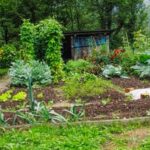Are you looking to create a beautiful and functional vegetable garden? Look no further than potager designs for vegetable gardens.
A potager garden is not just a practical space for growing vegetables, but also an aesthetically pleasing and organized area that combines fruits, vegetables, herbs, and flowers. In this article, we will delve into the history of potager gardens, the benefits they offer, essential elements of their designs, planning and layout tips, suitable plants to grow in them, maintenance and care advice, as well as creative accessories that can elevate the overall look of your potager garden.
Potager gardens have a rich history dating back centuries and have been popular in European countries such as France and England. We will explore how these traditional gardens have evolved over time and gained popularity worldwide due to their unique blend of beauty and functionality.
In addition to their visual appeal, potager gardens offer numerous benefits such as maximizing space, promoting biodiversity, and providing fresh produce right at your doorstep. By understanding the essential elements of potager designs and suitable plant choices for these gardens, you can create a vibrant and productive space that enhances both your culinary endeavors and outdoor living experience.
So whether you are a seasoned gardener or just starting out with your green thumb journey, this article will guide you through the world of potager designs for vegetable gardens.
History of Potager Gardens
The concept of potager designs for vegetable gardens has a rich and fascinating history that dates back to medieval times. The word “potager” is derived from the French term “potage,” which refers to a soup or stew.
In the 12th century, monks in France started incorporating vegetables, herbs, and flowers into their garden designs to create aesthetically pleasing and productive spaces. These gardens were not only practical for providing food but also served as beautiful, fragrant retreats for meditation and relaxation.
During the Renaissance period, potager gardens became popular among the nobility in Europe. These gardens were carefully planned and laid out in intricate geometric patterns, often arranged in raised beds or bordered with low hedges. The plants were selected not only for their culinary uses but also for their ornamental qualities, creating a visually stunning tapestry of colors, textures, and scents.
One of the most famous historical examples of potager gardens is found at Villandry Castle in France. The Chateau de Villandry features a series of meticulously organized and visually striking garden beds that showcase the principles of potager design. These gardens are divided into several sections, each devoted to different types of plants-vegetables, aromatic herbs, medicinal plants, and decorative flowers-all arranged in intricate patterns that emphasize symmetry and balance.
| Historical Period | Significance |
|---|---|
| Medieval Times | Monks incorporate vegetables, herbs, and flowers into garden designs for both practical and aesthetic purposes. |
| Renaissance Period | Potager gardens become popular among European nobility, featuring carefully planned layouts with ornamental qualities. |
| Villandry Castle | The Chateau de Villandry showcases the principles of potager design through meticulously organized garden beds with balanced arrangements. |
Benefits of Potager Gardens
Potager gardens offer a wide array of benefits for both the gardener and the environment. These gardens are not only aesthetically pleasing but also serve as a practical way to grow fresh produce while maintaining a beautiful outdoor space. Below are some of the key benefits of potager designs for vegetable gardens:
- Multi-functional Spaces: Potager gardens are designed to be both visually appealing and productive, making them a great use of garden space. By incorporating vegetables, herbs, and flowers in an organized and artistic manner, potager gardens serve as multi-functional spaces that provide beauty and sustenance.
- Increased Biodiversity: The combination of different plant species in a potager garden promotes biodiversity, creating a natural balance that can help ward off pests and diseases. This is especially beneficial for organic gardening practices as it reduces the need for chemical interventions.
- Improved Soil Health: Rotating crops, intercropping, and companion planting are common practices in potager gardens. These methods contribute to healthier soil by reducing nutrient depletion and preventing soil erosion. Additionally, diverse plantings can help improve soil structure and fertility over time.
In addition to these benefits, potager gardens also provide opportunities for stress reduction through gardening activities, promote sustainable living by reducing food miles and waste, and can even serve as educational tools for children or community members interested in learning about gardening and sustainable food production.
Ultimately, the advantages of potager designs for vegetable gardens go well beyond simply providing fresh produce; they encompass environmental sustainability, aesthetics, health benefits, and educational value.
Essential Elements of Potager Designs
When it comes to creating a stunning and functional potager garden, there are several essential elements that can help bring your design to life. From practical considerations to aesthetic appeal, these elements are crucial in achieving the traditional charm of a potager garden.
Divided Plots and Pathways
One of the defining features of a potager garden is its divided plots and pathways. This not only adds visual interest to the design but also serves a practical purpose by allowing for easy access to all areas of the garden. Dividing the space into smaller plots makes it easier to manage and maintain different types of vegetables and herbs.
Vertical Structures
Incorporating vertical structures such as trellises, arbors, or obelisks into your potager design not only adds height and visual appeal but also provides support for vining plants like tomatoes, cucumbers, or beans. Vertical structures can also serve as focal points within the garden, adding depth and dimension to the overall layout.
Mix of Vegetables, Herbs, and Flowers
A key characteristic of potager designs is the inclusion of a variety of vegetables, herbs, and flowers in a single integrated space. Mixing these different types of plants not only creates an attractive and diverse garden but also serves practical purposes such as companion planting and pest control. The combination of colors, textures, and scents adds another layer of beauty to the overall design.
Incorporating these essential elements into your potager garden design will help you create a beautiful and productive space that blends functionality with aesthetics. Whether you’re planning a small herb garden or a large vegetable plot, paying attention to these key elements will ensure that your potager garden flourishes in both form and function.
Planning and Layout of a Potager Garden
When it comes to planning and laying out a potager garden, there are several key elements to consider. Firstly, it is important to establish the size and shape of the garden. Potager gardens can range from small, intimate spaces to larger, more expansive layouts, so it’s essential to determine how much space you have available and how you want to use it.
Another crucial aspect of planning a potager garden is deciding on the layout and design. Traditional potager gardens often feature geometric patterns, with raised beds or pathways creating an organized and structured look. However, modern potager designs for vegetable gardens have also evolved to incorporate more organic shapes and fluid layouts, allowing for a more relaxed and natural aesthetic.
In addition to the overall layout, careful consideration should be given to the placement of specific plants within the potager garden. Grouping vegetables and herbs according to their individual requirements for sunlight, water, and soil type will help ensure optimal growing conditions and facilitate maintenance. Furthermore, incorporating trellises or vertical gardening elements into the design can maximize space and productivity in a potager garden.
Lastly, when planning and laying out a potager garden, it’s important to keep functionality in mind. Accessibility for watering, weeding, and harvesting should be prioritized, as well as considering any additional features such as seating areas or decorative elements that will enhance the overall appeal of the space.
| Key Elements | Considerations |
|---|---|
| Size and Shape | Determine available space |
| Layout Design | Choose between geometric or organic patterns |
Suitable Vegetables and Herbs for Potager Gardens
When it comes to designing a potager garden, one of the most important aspects to consider is the selection of suitable vegetables and herbs. The beauty of a potager garden lies in its ability to combine both aesthetic appeal and practical functionality, making it essential to choose plant varieties that not only look visually appealing but also serve a culinary purpose.
In a traditional potager garden, a variety of vegetables and herbs are often grown together in a structured and organized manner. Some popular choices for vegetables include tomatoes, lettuce, peppers, cucumbers, and carrots. These can be interspersed with an assortment of herbs such as basil, thyme, rosemary, and parsley. Not only does this combination provide an array of colors and textures for visual appeal, but it also ensures a bountiful harvest of fresh produce throughout the growing season.
In addition to aesthetics and practicality, it is important to consider the climate and soil conditions when selecting plants for a potager garden. It’s advisable to choose vegetable and herb varieties that are well-suited to the local climate and growing conditions in order to ensure successful cultivation.
By carefully considering these factors when choosing which plants to include in a potager garden, individuals can create a beautiful and productive space that enhances both the visual appeal of their outdoor area and their culinary experiences.
Maintenance and Care Tips for a Potager Garden
Potager gardens are not only beautiful but also practical and easily manageable. To ensure the health and longevity of your potager garden, regular maintenance and care are essential. Here are some tips to help you keep your vegetable garden thriving:
1. Weed Control: Regular weeding is crucial to maintain the neat and organized appearance of a potager garden. Be sure to remove any unwanted plants that may compete with your vegetables for sunlight, nutrients, and water.
2. Watering: Proper watering is key to a successful potager garden. Make sure to water your vegetable plants deeply but infrequently to encourage strong root growth. Consider installing a drip irrigation system or soaker hoses to deliver water directly to the roots of your plants.
3. Pest and Disease Management: Keep a close eye on your vegetables for signs of pests and diseases. Implement organic pest control methods such as introducing beneficial insects or using natural predators like ladybugs to keep harmful insects at bay.
4. Soil Care: The quality of the soil in your potager garden will directly impact the health of your vegetable plants. Regularly amend the soil with organic matter such as compost or aged manure to improve its fertility and structure.
5. Crop Rotation: To minimize soil-borne diseases and maintain soil fertility, practice crop rotation by planting different types of vegetables in different areas of your potager garden each year.
By following these maintenance and care tips, you can ensure that your potager garden remains in top condition, providing you with an abundance of fresh produce throughout the growing season.
Creative and Functional Accessories for Potager Gardens
When it comes to creating a beautiful and functional potager garden, the right accessories can make all the difference. From practical tools to decorative elements, incorporating creative and functional accessories can enhance the overall aesthetic and productivity of your vegetable garden.
One essential accessory for any potager garden is a set of high-quality gardening tools. Investing in durable hand trowels, pruners, and watering cans can make maintaining your garden much easier and more enjoyable. Additionally, consider adding a sturdy trellis or support system for climbing vegetables such as tomatoes, cucumbers, and peas. This not only adds visual interest to your garden but also helps maximize space and yield.
Incorporating decorative elements into your potager garden can elevate its visual appeal. Consider adding ornamental features such as birdbaths, statuary, or decorative planters for a touch of charm. For a more practical approach, install path lighting or decorative fencing to enhance both the safety and aesthetics of your garden space. Additionally, consider adding seating areas or cozy corners where you can relax and enjoy the beauty of your flourishing vegetable garden.
Another vital accessory for potager gardens is proper irrigation systems. Consider installing drip irrigation or soaker hoses to ensure that your plants receive consistent moisture without wasteful runoff. Accessories such as rain barrels can also help you collect and conserve water, promoting sustainability in your garden. Whether practical or decorative, these accessories can complement your potager design while improving functionality and efficiency in your vegetable garden.
Examples of Stunning Potager Designs Around the World
Potager gardens have been popular in Europe for centuries, but their influence has now spread around the world. These stunning designs can be found on various continents, each with its unique features and characteristics. Here are a few examples of potager gardens that will inspire and awe any vegetable gardening enthusiast.
French-Inspired Potager Garden in the United States
One remarkable example of a stunning potager garden can be found in the United States, specifically in the Pacific Northwest. This garden draws inspiration from traditional French potagers, with its geometrically arranged raised beds, gravel paths, and intricate trellises. The combination of vibrant vegetables, aromatic herbs, and colorful flowers creates a visually captivating display that is both functional and aesthetically pleasing.
Asian-Influenced Potager Garden in Australia
In Australia, there is an emerging trend of blending traditional potager designs with Asian influences. One particular garden stands out with its harmonious integration of Japanese landscaping principles and practical vegetable cultivation. This unique fusion results in a serene and contemplative space that celebrates the beauty of nature while providing an abundant harvest of produce.
Mediterranean-Inspired Potager Garden in Spain
The Mediterranean region is renowned for its bountiful produce and rich culinary heritage. In Spain, there are exemplary potager gardens that reflect this cultural influence with terracotta pots overflowing with tomatoes, peppers, and fragrant herbs like rosemary and thyme. The use of colorful tiles, ornamental fountains, and shady pergolas adds a touch of elegance to these gardens, making them not only productive but also inviting spaces for relaxation and enjoyment.
These examples demonstrate the versatility and adaptability of potager designs for vegetable gardens across different geographical locations. Whether it’s a traditional French-inspired layout or an innovative fusion of styles, these stunning potager gardens showcase the endless possibilities for creating beautiful and productive outdoor spaces.
Conclusion
In conclusion, potager designs for vegetable gardens offer a beautiful and functional way to cultivate your own produce while enhancing the aesthetic appeal of your outdoor space. As we’ve explored in this article, the history of potager gardens dates back centuries, highlighting their enduring popularity and timeless design elements. The benefits of potager gardens are numerous, from providing fresh, organic produce to creating a visually stunning and productive landscape.
When planning a potager garden, it’s important to consider the essential elements such as layout, pathways, and decorative features that will enhance both the practicality and beauty of the space. Additionally, choosing suitable vegetables and herbs for your potager garden is crucial to ensure a bountiful harvest throughout the growing season.
Furthermore, maintenance and care tips are essential for keeping your potager garden in optimal condition, while creative accessories can add personal flair and functionality. Finally, drawing inspiration from stunning examples of potager designs around the world can provide valuable ideas and insights for creating your own unique and breathtaking garden. With careful planning and thoughtful consideration of these elements, you can cultivate beauty and functionality with potager designs that will delight both the eye and the palate.
Frequently Asked Questions
What Is the Best Layout for a Vegetable Garden?
The best layout for a vegetable garden depends on various factors such as the available space, sunlight exposure, and types of vegetables being grown. Generally, it’s good to place taller plants like corn or tomatoes in the north to avoid shading smaller plants.
How to Design a Potager?
Designing a potager involves creating a garden that is not only functional but also aesthetically pleasing. A key aspect is incorporating both vegetables and flowers into the design, often arranged in geometric patterns or distinct sections. Paths and edging can also enhance the overall look of the potager.
What Is the French Style of Vegetable Gardening?
The French style of vegetable gardening, known as “potager” gardening, focuses on creating an ornamental yet productive garden space. It typically incorporates raised beds, paths made from gravel or grass, and a mixture of vegetables, herbs, and flowers arranged in a visually appealing manner.

If you’re looking to get into vegetable gardening, or are just looking for some tips on how to make your current garden better, then you’ve come to the right place! My name is Ethel and I have been gardening for years. In this blog, I’m going to share with you some of my best tips on how to create a successful vegetable garden.





